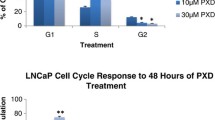Abstract
Benign prostate hyperplasia (BPH) is a disease of the aging male. In BPH, the imbalance of cell proliferation and programmed cell death (apoptosis) leads to continuous stromal growth. Common medication interrupts stromal cell proliferation but has only little effect on inducing stromal cell apoptosis. In this study, we investigated tamoxifen (TAM) and 4-hydroxytamoxifen (OHT) for their ability to induce apoptosis in human prostate stromal cells (PrSC) in vitro. After the incubation of PrSC with different concentrations of TAM or OHT, the cytotoxic effect was measured using an MTT-assay. The induction of apoptosis after OHT treatment was investigated by FACS-analysis (annexin V FITC staining) and Western blot (PARP-1 cleavage, BCL-2 and BAX-α expression). The administration of TAM at concentrations of 0–20 µM had very little effect on cell viability as measured by MTT assay. In contrast, the use of 10–20 µM OHT led to a significant decrease in cell viability. The binding of annexin V FITC to apoptotic cells was demonstrated by FACS-analysis. The induction of apoptosis was further proven by Western blot of PARP-1 protein cleavage and the expression of the anti-apoptotic BCL-2 and the pro-apoptotic BAX-α proteins. In conclusion, our data clearly demonstrate, that the administration of OHT at concentrations from 10–20 µM induced apoptosis in human PrSC. The more effective induction of apoptosis with OHT compared with TAM could very well explain the results of clinical studies showing no clinical effect of TAM treatment on BPH. Furthermore, our results, if reproducible in vivo, could open new avenues for the treatment of BPH by local administration of OHT in apoptosis-inducing concentrations.





Similar content being viewed by others
References
Bartsch G, Oberholzer M, Rohr HP (1981) The effect of antiestrogen, antiandrogen, and the prolactin inhibitor 2 bromo-alpha-ergocriptine on the stromal tissue of human benign prostatic hyperplasia. Correlation of stereological data and plasma hormones. Invest Urol 18: 308
Cardillo M, Berchem G, Tarkington M (1997) Resistance to apoptosis and up regulation of BCL-2 in benign prostatic hyperplasia after androgen deprivation. J Urol 158: 212
Coezy E, Borgna JL, Rochefort H (1982) Tamoxifen and metabolites in MCF7 cells: correlation between binding to estrogen receptor and inhibition of cell growth. Cancer Res 42: 317
Cuellar DC, Kyprianou N (2001) Future concepts in the medical therapy of benign prostatic hyperplasia. Curr Opin Urol 11: 27
Diel P, Smolnikar, K, Michna, H (1999) The pure antiestrogen ICI 182780 is more effective in the induction of apoptosis and down regulation of BCL-2 than tamoxifen in MCF-7 cells. Breast Cancer Res Treat 58: 87
Dutkiewics S (2001) Efficacy and tolerability of drugs for treatment of benign prostatic hyperplasia. Int Urol Nephrol 32: 423
Hanus M, Matouskova M (1993) Antiestrogens (tamoxifen) in the alternative therapy of benign prostatic hyperplasia. Rozhl Chir 72: 316
Mandlekar S, Yu R, Tan TH, Kong AN (2000) Activation of caspase-3 and c-Jun NH2-terminal kinase-1 signaling pathways in tamoxifen-induced apoptosis of human breast cancer cells. Cancer Res 60: 5995
Perry RR, Kang Y, Greaves B (1995) Effects of tamoxifen on growth and apoptosis estrogen-dependent and -independent human breast cancer cells. Ann Surg Oncol 2: 238
Pieters R, Loonen AH, Huismans DR et al. (1990) In vitro drug sensitivity of cells from children with leukemia using the MTT assay with improved culture conditions. Blood 76: 2327
Rittmaster RS, Norman RW, Thomas LN (1996) Evidence for atrophy and apoptosis in the prostates of men given finasteride. J Clin Endocrinol Metab 81: 814
Romijn JC, Verkoelen CF, Schroeder FH (1988) Application of the MTT assay to human prostate cancer cell lines in vitro: establishment of test conditions and assessment of hormone-stimulated growth and drug-induced cytostatic and cytotoxic effect. Prostate 12: 99
Stone NN, Clejan SJ (1991) Response of prostate volume, prostate-specific antigen, and testosterone to flutamide in men with benign prostatic hyperplasia. J Androl 12: 376
Treon SP, Teoh G, Urashima M (1998): Anti-estrogen induce apoptosis in multiple myeloma cells. Blood 5: 1749
Turkeri LN, Ozyurek M, Ersev D (2001) Apoptotic regression of prostatic tissue induced by short-term doxazosin treatment in benign prostatic hyperplasia. Arch Esp Urol 54: 191
Wang X, Ye H, Jiang H (1988) Influence of androgen on BCL-2 mRNA expression in BPH tissue. Zhonghua Wai Ke Za Zhi 38: 198
Weinmann P, Gaethgens P, Walzog B (1999) BCL-X1-and Bax-α-mediated regulation of apoptosis of human neutrophils via caspase-3. Blood 9: 3106
Acknowledgement
The technical assistance of Elsie Oppermann, Department of General Surgery, is gratefully acknowledged.
Author information
Authors and Affiliations
Corresponding author
Rights and permissions
About this article
Cite this article
Glienke, W., Dolgova, Y., Müller, I. et al. Induction of apoptosis in human prostate stromal cells by 4-hydroxytamoxifen: an alternative therapy for benign prostate hyperplasia. World J Urol 22, 452–456 (2004). https://doi.org/10.1007/s00345-004-0450-8
Received:
Accepted:
Published:
Issue Date:
DOI: https://doi.org/10.1007/s00345-004-0450-8




